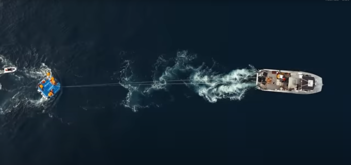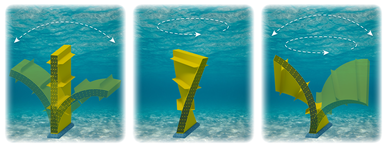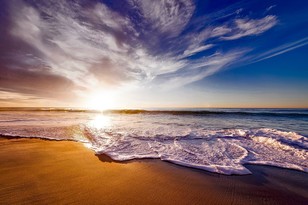Upcoming Deadlines
Announcements & Opportunities
WPTO Announces $10 Million Funding Opportunity to Advance Marine Energy Innovation: The U.S. Department of Energy’s (DOE) Water Power Technologies Office (WPTO) published a notice of intent to issue a $10 million funding opportunity to support wave-powered technology innovation for seawater desalination, research and development for powering blue economy markets, and a feasibility assessment for an ocean-current test facility. WPTO expects to release the funding opportunity in the coming weeks.
TEAMER Announces Latest Round of Technical Support: The U.S. TEAMER program recently announced seven projects that will receive technical support. These projects will be able to access testing expertise as well as numerical modeling, laboratory or bench testing, and tank or flume testing and expertise through the growing TEAMER Facility Network. TEAMER is accepting applications through Nov. 4, 2022, for its next round (round 8) of technical support.
Applications Now Open for Marine Energy Graduate Student Research Program: WPTO and the Oak Ridge Institute for Science and Education are now accepting applications for the Marine Energy Graduate Student Research Program. Previously only open to doctoral students, the program is accepting applications from all graduate-level (master’s and doctoral) students for the first time. The program is designed to advance the students’ marine-energy-focused theses by providing access to the expertise, resources, and capabilities available at DOE offices, national laboratories, industry partners, and other approved facilities. Applications are due Dec. 2, 2022.
Upcoming Events
WPTO R&D Deep Dive: Small WEC Analysis in the Palm of Your Hand
TOMORROW, Sept. 29, 2022, 1–2 p.m. ET, Online
Explore and compare small wave energy converter (WEC) performance with the Small WEC Analysis interactive modeling tool. This tool uses performance data from downscaled models of common WEC devices and their calculated performance outputs. The devices include a point absorber, a two-body point absorber, an oscillating surge device, and an attenuator-type device (McCabe Wave Pump). One of the primary use cases for this work is to offer an easy way to compare power output for a variety of WECs and model sizes. This publicly available and easily accessible performance library is designed to expand WEC analysis access to a more diverse field of technology developers without requiring hydrodynamic experience.
Register for the webinar.
Products & Publications
Empowering the Next Generation of Marine Energy Experts: Marine energy could be an important contributor to a clean energy future in the United States, and WPTO offers a range of educational resources to teach students of all ages about this renewable energy resource. Learn more about these resources and how parents, caregivers, and teachers can generate buzz about marine energy in and out of the classroom.

CalWave Concludes Open-Ocean Wave Energy Pilot: CalWave Power Technologies, Inc. (CalWave) successfully concluded its open-ocean wave energy pilot after 10 months of continuous operation off the coast of San Diego, California. The project, supported by funding from WPTO, aimed to demonstrate CalWave’s xWave technology, which transforms the motion of ocean waves into electricity. This demonstration represented California’s first at-sea, long-duration wave energy project and a critical step toward providing wave power as a commercially viable renewable resource.
CNBC Covers Wave Energy’s Potential to Help Power the Clean Energy Future: The opportunities to harness marine energy are abundant. The total available marine energy resource in the United States is equivalent to approximately 57% of all U.S. power generation in 2019. Hear from WPTO Director Jennifer Garson and other marine energy experts about how they are working to turn this potential for marine energy into reality.
|

NREL’s New Patent for DEEC-Tec Could Generate Clean Energy From Waves: Distributed embedded energy converter technologies, or DEEC-Tec, could capture naturally occurring energy sources from ocean and river waves, currents, and tides. The first DEEC-Tec patent in marine renewable energy could eventually transform sources of everyday energy into electricity or other forms of usable energy.
Marine Energy Economics Covered in New Handbook: The Pacific Northwest National Laboratory’s (PNNL) Dhruv Bhatnagar, Danielle Preziuso, and Rebecca O’Neill contributed their expertise on the economics of marine energy in the latest The Palgrave Handbook of International Energy Economics, which takes a comprehensive look at the biggest economic issues in the energy sector today.
Tied To The Ocean: Watch a short video series produced by PNNL to meet three marine scientists who are advancing the ocean’s role in a clean energy future. From coastal modeling to marine ecology and engineering, theri work is helping to harness the incredible potential of marine energy, minimize environmental impacts, and support resilient coastal communities.
|
In Case You Missed It
DOE and NOAA Announce Winners of Ocean Observing Prize BUILD Contest Designed to Advance Hurricane-Monitoring Systems: DOE and the National Oceanic and Atmospheric Administration (NOAA) announced the winners of $500,000 in the BUILD Contest, the second phase in the Ocean Observing Prize’s DEVELOP Competition. The prize challenges competitors to develop solutions that use marine energy to power hurricane-monitoring systems. The teams tested their early-stage prototypes in the state-of-the-art Maneuvering and Seakeeping Basin—also known as the U.S. Navy’s indoor ocean—at the Naval Surface Warfare Center’s facility in Carderock, Maryland.
Twelve Small Businesses Receive Funding to Further Water Power Research and Development: DOE announced $12 million for 12 hydropower and marine energy projects as part of the Small Business Innovation Research and Small Business Technology Transfer programs. These small-business-led projects, selected by WPTO, will drive innovation in water power technologies and contribute to the Biden administration’s goals of a carbon-free power sector by 2035 and a net-zero-emissions economy by 2050.
Q&A With Jonathan Colby, Chair of the International Electrotechnical Commission, on the Future of Marine Energy: Read an interview with Jonathan Colby, chair of the International Electrotechnical Commission, and see how he thinks marine energy can play a crucial role in the clean energy transition as well as the challenges of developing standards for a rapidly evolving sector.
Social Spotlight
WPTO on LinkedIn—Sept. 12, 2022

How is marine energy capture and once it is captured, how does it work? Explore how this abundant, predictable, and renewable energy resource can power more than just your community.
|
Follow along on the Office of Energy Efficiency & Renewable Energy (EERE) Twitter, LinkedIn, and Facebook channels for more #WaterWednesday content each week.
WPTO in the News
-
Patented Wave Energy Technology Gets Its Sea Legs, CleanTechnica, Caitlin McDermott-Murphy (NREL), Sept. 21, 2022
-
The Navy’s Indoor Ocean Tests Seagoing Vessels Before They Ship Out, Popular Mechanics, Manasee Wagh, Sept. 20, 2022
-
Marine Energy Research Program for Graduate Students Opens in the US, Offshore Energy Biz, Amir Garanovic, Sept. 14, 2022
-
CalWave Successfully Concludes Historic Wave Energy Pilot in California, Yahoo News, Staff Writer, Sept. 1, 2022
Marine Mentions
-
Five Wave Energy Projects Proceed to Next Phase of EuropeWave, Offshore Energy Biz, Amir Garanovic, Sept. 22, 2022
-
The Future of Ocean Wave Power Generation Technology, EC&M, Tom Zind, Sept. 21, 2022
-
Minesto to Showcase Benefits of Predictable Ocean Energy at COP27, Offshore Energy Biz, Amir Garanovic, Sept. 20, 2022
-
Waveram Concludes Tank Tests for Streamlined Wave Energy Device, Offshore Energy Biz, Amir Garanovic, Sept. 19, 2022
-
Scientists Claim Nanogenerators Could Produce Significant Electricity From Sea Waves, Interesting Engineering, Staff Writer, Sept. 18, 2022
-
Hydroelectric Turbines in River Thames ‘Could Help Power Parliament’, The Independent, Harry Cockburn, Sept. 13, 2022
-
Israeli Start-Up Uses Wave Power To Generate Electricity, Globe World News, David Sadler, Sept. 11, 2022
-
Oneka Water Desalinates Water Without Energy or Toxic Waste, Inhabitat, Dawn Hammon, Sept. 9, 2022
-
Minesto Starts Commissioning of Second ‘Dragon 4’ Tidal Energy Power Plant, Energy Global, Abi Larkin, Sept. 7, 2022
-
Harnessing the Power of Waves to Create Power, The Statesman, Prashant Kumar, Sukhwinder Kaur, and Armin Rosencranz, Sept. 7, 2022
-
How Do Tides and Turbines Affect Sealife? Fundy Study Hopes to Find Out, CBC News, Moira Donovan, Sept. 6, 2022
|